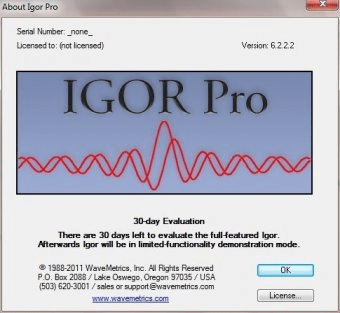

The source is considered to be "matched" when loaded by an impedance exactly equal to its output source impedance. The source impedance of the microphone and the load impedance of the mic preamp form a voltage divider between the theoretically zero Ohm source microphone and the theoretically infinitely high input impedance (Z) mic preamp.Īlthough the term "impedance matching" is incorrectly and loosely used to describe any adjustment to the impedances of the microphone/preamp interface, the term "matched impedance" has a very specific meaning which applies to all electronics including mic to preamp interfacing.
Igor pro remove ringing and overshoot generator#
Since the microphone's output source impedance lies between the theoretically perfect microphone internal signal generator and the load, there will be some loss across the source impedance caused by the input impedance of the preamp. Depending on the microphone, this output source impedance may be mostly resistive, somewhat capacitive and maybe inductive, depending on the microphone's design. There are a lot of transformerless mics that have output impedances in the 30 to 50 Ohm range, and most microphones that incorporate an output transformer have output source impedances in the 150 to 250 Ohm range. Or it may be greater than 600 Ohms in some ribbon mics.
Igor pro remove ringing and overshoot series#
In some very low output impedance transformerless microphone designs, this equivalent series impedance magnitude may be as low as 12 Ohms. In series with that zero Ohm generator is a complex impedance (having magnitude and phase) which is the output source impedance of the mic.

This generator can be thought of as having infinitely low output (source) impedance - one that can be loaded with 1 milliOhm and still not drop in voltage level. One may think of the microphone's output as a Zero Ohm signal generator in series with an impedance. Microphone output source impedance is a little bit more difficult concept to initially grasp. When you switch in the resistive pad to such a preamp, then the microphone will see a much more resistive load because the pad resistors interface between the microphone and the input transformer so the mic sees the resistors in the pad as the load. Usually the midrange impedance is on the order of 1000 to 2000 Ohms. In general, for example, a transformer-based preamp input will have an impedance that is quite flat in the midrange but becomes lower at both low and high frequencies due to the transformer inductance at low frequencies and the input capacitance at high frequencies. This impedance is not just a resistive load, but contains capacitive and inductive reactance which makes the impedance vary with frequency. Infinitely high impedance when placed across a signal source will not cause any drop in signal level. It can be thought of as a complex impedance placed in parallel with a preamp input with theoretically infinitely high input impedance. Load impedance is the complex magnitude and phase presented to the microphone by the preamp circuitry. The following discussion, however, relates to those who desire to capture the music with the most faithful fidelity possible without intentional coloration. That's totally OK in the name of artistic license. We also want to interface our microphone to the preamplifier in a way that maintains the best fidelity.Įxceptions to this generalization abound because some recordists intentionally modify the loading to certain microphones in order to change the way they sound. The game plan is to increase the level of the desired signal and minimize any electrical noise coming from the mic.

Microphones produce relatively low-level signals that must be amplified in order to be brought up to useable levels. Because this link was sent to me by an inquiring client, and it seems that I might be able to shed further light on the impedance issues regarding microphones, I will offer some basics.įirst the theory (which varies in the real world, as I will explain later):


 0 kommentar(er)
0 kommentar(er)
